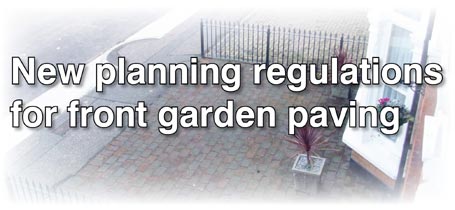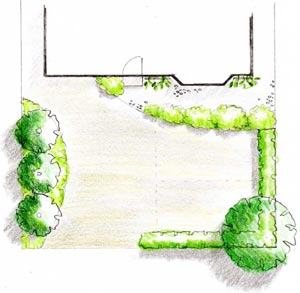Front Garden Paving - Healthy Life Essex
Home » Articles » Sustainability » Front Garden Paving
New planning regulations for front garden paving

Paving your front garden? Don’t forget the SUDS!
| New planning regulations introduced on 1st October 2008 now affect how you can pave your front garden. Jill Crooks of Room 105 Design Partnership explains the new regulations and provides design ideas so you will be able to have a practical, attractive, environmentally friendly hard standing area for your cars that is SUDS compliant (Sustainable Urban Drainage Systems). |
Why is there a need for change?
Flooding and drainage are now major environmental issues. Surface water run-off was one of the main causes of the flooding disasters of 2007, with drainage systems and subsequently rivers unable to cope with such significant amounts of water.
 The paving over of front gardens has had a significant impact on the volume of water running into drains; in London there are 12 square miles of front garden under paving, equivalent to 22 Hyde Parks. Government reports estimate that over 80,000 homes are at very high risk from surface water flooding causing £270 million of damage each year.
The paving over of front gardens has had a significant impact on the volume of water running into drains; in London there are 12 square miles of front garden under paving, equivalent to 22 Hyde Parks. Government reports estimate that over 80,000 homes are at very high risk from surface water flooding causing £270 million of damage each year.
Besides flooding there are many other environmental issues created by the increasing spread of paving:
- Oil, petrol & brake dust is washed off paving causing pollution in rivers.
- Older drains carry rainwater into sewers which can overflow into rivers.
- Local temperatures can rise (the urban heat island effect) due to less evaporation of water that would have soaked into the ground and more hard surfaces releasing heat absorbed during the day.
- Less vegetation means poorer air quality – trees play a major part in absorbing dust & pollution.
- Loss of habitat for wildlife.
New Legislation
In England, as of the 1st October 2008, permission is now required to install any impermeable paving in front gardens, exceeding 5 m2, which allows uncontrolled rainwater to run into the road.
At present this affects only new and extended installations at the front of a property adjacent to a road, e.g. if you are having a new driveway or hard-standing laid or replaced.
This includes the traditional installation of:
- Concrete
- Tarmac
- Paving slabs that are cemented in place
The government have recognised that permeable paving isn’t always suitable for the site, e.g. heavy clay will not disperse water very quickly. The issue is what happens to the rainwater so an impermeable material could be laid without needing planning permission providing rainwater is dispersed or channelled by one or any of the following methods:
- Storing it for recycling
- Releasing it immediately into the ground on site – e.g. into soakaways
- Providing a controlled release into existing drainage
The bottom line is that drainage needs to be SUDS compliant in order to avoid requiring planning permission.
SUDS
This is not a reference to the soap in your bath water but stands for Sustainable Urban Drainage Systems, it’s all about the type of paving & drainage system used to control rain water at its source rather than washing it into public drains.
What products can be used without needing permission?
There are many types of permeable hard surfaces that are suitable for driveways, which would be allowed under permitted development rights:
Gravel
Gravel is the cheapest hard landscaping option and good for larger drives. The downside is the fluidity of the surface making it unsuitable for wheelchairs and pushchairs etc.
 However, there are now stabilisation products available that are based on a grid system that prevents gravel from moving about. These products are great for providing a natural look whilst providing a firmer surface for wheels. It also has an inbuilt membrane that stops the gravel falling through and acts as a weed suppressant.
However, there are now stabilisation products available that are based on a grid system that prevents gravel from moving about. These products are great for providing a natural look whilst providing a firmer surface for wheels. It also has an inbuilt membrane that stops the gravel falling through and acts as a weed suppressant.
Permeable Resin Bound Surface
 Gravel, or other types of aggregate, can be bonded to create a firm but porous surface, providing this is applied to a permeable base. This is a very versatile product that is becoming more popular. As the resin is clear you see the natural colour of the aggregate rather than a black tarmac based binding material.
Gravel, or other types of aggregate, can be bonded to create a firm but porous surface, providing this is applied to a permeable base. This is a very versatile product that is becoming more popular. As the resin is clear you see the natural colour of the aggregate rather than a black tarmac based binding material.
 Permeable Block Paving
Permeable Block Paving
Whether concrete or clay, this is similar in looks to the traditional block paving but the blocks have spacers to create wider gaps. The construction and make-up of the base materials is very different to allow water to pass through.
 Permeable Macadam (or tarmac)
Permeable Macadam (or tarmac)
Believe it or not an open graded tarmac surface can be porous, and as with all surfaces this is dependant on (yes you’ve guessed it) the permeability of the base. Lighter coloured aggregates can be used in the mix for a more individual look.
Reinforced grass
 This product is very similar to the gravel stabilisation product, except the cells, which can be plastic or concrete, are filled with sand / topsoil and grass seed. This solution is suitable for larger front gardens where grass is a more practical option and where the area is not permanently parked on so that the grass has sufficient light to grow.
This product is very similar to the gravel stabilisation product, except the cells, which can be plastic or concrete, are filled with sand / topsoil and grass seed. This solution is suitable for larger front gardens where grass is a more practical option and where the area is not permanently parked on so that the grass has sufficient light to grow.
Impermeable but SUDS compliant
It is vital that the type of surface & drainage system is suitable for the site conditions e.g. soil type, whether there is sloping ground or the level of the water table. Heavy clay soil and compacted ground is extremely slow to absorb water and would therefore result in puddling during heavy rain. In these circumstances it is better to use drainage systems that will direct and control the flow of excess water into a planted border or soakaway.
‘Greening’ our front gardens
The environmental benefits of managing water within our gardens should not be considered without the inclusion of appropriate planting. By ‘greening’ our front gardens we are providing a natural reservoir for the uptake of run-off water, much needed food and shelter for wildlife and we are improving the look of our property, therefore adding value and increasing saleability. Consider the way you feel when driving down a leafy green avenue compared to a street lined with concrete & cars.
It has to be accepted with our current lifestyles we often need off-road space for more than one car per family. However there is always room for some planting which can still be low maintenance. The illustrations below provide some ideas of what can be achieved.
A terraced house with options for single and double parking

|
Single parking Hard Landscaping Pathway – gravel stabilisation suitable for pushchairs Always consider the vertical elements when planning what to include. A pergola provides support for scented climbers and could also be used to hang bird feeders Planting |
Double parking Hard Landscaping Wheel tracks can be created with paving and the area outside the tracks laid with permeable resin bound gravel or gravel stabilisation that will not scatter around In between tracks can be planted with hardy, low growing plants – providing cars are not left parked for long periods Planting |
A detached house with parking for a minimum of two cars
(options could easily apply to a semi-detached property)

|
 |
|
Hard Landscaping Pathway – permeable block paving Additional parking area – this provides an extra space for a small car and could be surfaced with a loose gravel (over a membrane) so that plants can be grown through Planting |
Hard Landscaping Area around house – gravel stabilisation with planting areas cut out or loose gravel with a small area of paving leading to the front door Trellis panels are positioned either side the bay window for climbers |
The options are numerous but the key point when choosing materials and planting is that they are appropriate for the site. This will require carrying out soils tests to check the permeability and a good understanding of levels.
One other point of note is that generally building regulations are not required for driveways, however government guidelines state that “when altering existing driveways make sure that any alterations do not make access to the dwelling any more difficult than it was before”, otherwise it may be a contravention of the regulations.
Further information can be found on the following websites:
www.communities.gov.uk/publications/planningandbuilding/pavingfrontgardens
www.planningportal.gov.uk/uploads/hhg/houseguide.html (shows the governments definition of a front garden area)
www.opsi.gov.uk/si/si2008/pdf/uksi_20082362_en.pdf (the full legislation)
| Jill Crooks, Garden Design Diploma – Writtle College RHS General & Advanced Certs. in Horticulture |
 |
